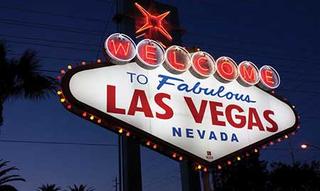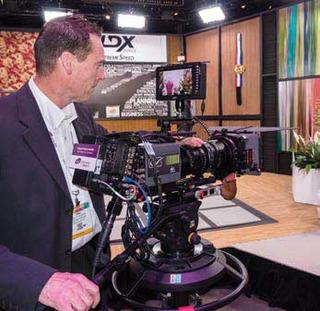2015 NAB Show Redefines Itself

LAS VEGAS—For those that may not normally think of the NAB Show as their own—whether you are an online video distributor or film marketer or the like—the NAB is saying: think again.
How does an organization that wholly defines itself as broadcast- centric—whose lobbying efforts are squarely focused on the nation’s radio and television broadcasters—cater to those who are not? At its Washington headquarters, the focus is not on MSOs, nor bloggers, nor podcasters. But once the industry arrives at convention itself, it’s clear that all of these media ventures have a presence in sessions and conferences that are designed to introduce the professional media industry to a new, innovative way of doing business.
Are these market segments threats, or valuable partners? The answer is yes. And it’s also no. And that’s where the struggle comes in.
FOCUS ON COMPELLING CONTENT
At no time is this dilemma more apparent than on cusp of the annual NAB convention, when more than 90,000 attendees and 1,700 exhibiting companies are set to head into the desert to see what’s new, what’s working and what’s already started to fall behind. It’s become a massive show— both in terms of focus and physical size— so much so that it’s hard to know where to begin.
Over the last several years, the convention has openly welcomed an ever-more-diverse group of content developers and engineers. Does that mean the convention has found the right balance between representing the core broadcast industry as well as courting new media players?
“[The NAB Show] brings together content creators and distributors covering all media platforms. That means friends, competitors, partners, you name it,” said Chris Brown, executive vice president, NAB Conventions and Business Operations. “All gain so much more when they can sit together to share ideas.”
For those that may not normally think of the NAB Show as theirs—namely online video distributors and others from the so-called non-traditional side of the industry— the organization has introduced a number of new programs. “[Introducing these new programs is] driven by the fact that the growth on this side of the media ecosystem just continues to accelerate, but part of it was also driven by a desire to make it very clear that the NAB Show provides a great home and learning lab for anyone playing in this space,” Brown said.
Get the TV Tech Newsletter
The professional video industry's #1 source for news, trends and product and tech information. Sign up below.
Yes, the NAB has reached out to every player in the communications space, said Dennis Wharton, executive vice president of Communications for NAB. “The fact is that we’ve got this huge Hollywood influx where we’re focusing on how content comes to life and we’re bringing in the Internet players and all sorts of other technologies,” which led to the introduction of a new drone pavilion, increased focus on government and education and intense interest in IP.
About 20,000 attendees are from the broadcast sector. “That leaves 80,000 who aren’t traditional broadcasters but are from the video post-production, Internet, satellite, government,” he said.
A 2014 Nielsen report found that “millennials” (those born between the early 1980s and 2000), are ditching traditional television viewing at higher rates than in previous years. According to the study, television usage fell about 10 percent between September 2014 and January 2015, an increase of about 4 percent per year since 2012. That equates to almost 20 percent fewer young adults watching traditional television than four years ago.
“We are concerned,” said NAB’s Wharton when asked about the decrease. “We’re the first to admit that this is not your parents’ television viewing experience.”
NEXT-GEN BROADCAST AND OTT
NAB is attempting to address the problem with technology—creating companion aps and complementary online sites. “We want to be where the eyeballs are, on tablets and mobile, and responding to meet that need,” Wharton said, suggesting that the migration away from traditional television viewership seems to be impacting cable more than broadcasting as more individuals “bypass the middle man” in favor of getting content through broadcast and broadband, he said.
“At the end of the day, broadcast will do OK in this brave new world so long as we’re delivering compelling content,” he said.
Other challenges loom on the horizon, too, from spectrum auctions to the development around ATSC 3.0. As the industry watches the work that’s being done on the next-generation broadcast standard, the NAB Show will serve as a place for asking questions and finding answers. Sessions on the issue include “Overview of the ATSC 3.0 Effort” and “Inside ATSC 3.0 – What’s Happening Where.” The FCC, which will be represented at the NAB Show by the chairman and all four commissioners, will likely discuss the development of the 3.0 standard and the ways in which the standard might be used in the incentive auction repacking process.
Broadcasters are watching as well. “At the end of the day, we don’t want to have broadcast technology be a second-class citizen,” Wharton said. “If you’re interested in making sure that broadcast maintains its historic leadership in transmission technology, then you have to be interested in 3.0.”

4K is expected to continue its drive towards resolution dominance at the NAB Show. One of the bigger trends expected to be discussed at the show is over-the-top video delivery, or OTT, which is serving as both an opportunity and challenge for when it comes to which platforms to choose and what kind of content to deliver. In the last year, CBS started its “All Access OTT” service and HBO announced “HBO Now,” with NBC expected to make a similar announcement in the months ahead. “This is a natural reaction to the way consumers are shifting their viewing and listening habits,” said Brown. “More and more they are looking to OTT options, and content providers need to follow the audience. They know that it is vital that their content remain in front of those consumers on as many devices and platforms as possible.”
The conference will respond with sessions such as “Constant Cravings – Using OTT to Win the Next Generation of Viewers,” and sections of the show floor such as the Connected Media IP Pavilion. The organization is also introducing a new two-day Online Video Conference and a Digital Strategies Exchange for Television program.
SPECTRUM AUCTIONS AND 4K
Other business at hand is the ongoing conversation over the upcoming spectrum auctions. The session “Television Spectrum Auction and Repack Update” will share the basics; the discussion will probably get a bit more heated at the “FCC Incentive Auction” session chaired by Commissioner Michael O’Rielly. Just prior to press time, the NAB was awaiting results of a hearing to receive clarification on several auction issues, including whether the $1.75 billion fund that has been set aside to compensation broadcasters will be sufficient to compensation all broadcasters who are repacked.
“It could be another $1 billion that may have to be paid out of pocket for those who have to move,” Wharton said. “We want to make sure that stations don’t get moved and then are asked to dip into their own wallets to come up with millions to fund their own relocation.”
Another key focus at the show will be 4K. “There’s no doubt that there will be more and more companies on the exhibit floor—representing the entire content lifecycle, from acquisition to production to delivery—with demos of new 4K products,” Brown said. “We are seeing consumer demand for 4K television sets increase as well as more content being produced, so the manufacturers of the gear required to capture and distribute this content are all adding products addressing this technology.”
The conference will touch on 4K during the Technology Summit on Cinema, the Post|Production World Conference and the Broadcast Engineering Conference, where there will be more than 30 sessions with a 4K focus.
“[Broadcasters] need to not just embrace the next generation of technology but future- proof [their work],” said Randall Dark, a 4K film maker who is working on “Moving Images,” a 4K documentary on the 100- year history of SMPTE’s film and television work. Working in a format like 4K involves not only the emotional impact of high-resolution imagery but assures those stories will be future proofed. “Film has always had a poetic emotion to it, a magic feel,” he said. “I think 4K can deliver that promise as well,” whether it humanizes the emotional or highlights the horrific, he said. “When you do a documentary about the environment having been devastated by natural disaster or war, and you shoot in 4K, you see the reality and it touches the human spirit,” Dark said. “You can’t sit there passively and watch 4K stories.”
TRANSITION TO IP
And then there’s IP. The Super Session titled “Television’s Transition to an All-IP Future – Why It’s a Big Deal,” will give a broad view on the transition to IP infrastructure and a new live, guided tour entitled “Connected Production via IP” will walk attendees across the show floor.
One of the most important things to understand is why there now seems to be a concerted effort to begin to transition studio infrastructures to IP.
Items like cameras, transmitters and lighting will remain non-IT in nature, but all other products are likely to become software-based, said author and media consultant Al Kovalick. For broadcasters heading out to NAB, it’s important to look at all things IT, Ethernet, IP, virtualized and cloud-related, he said, and question vendors as to their views on IP/Ethernet replacing SDI.
Susan Ashworth is the former editor of TV Technology. In addition to her work covering the broadcast television industry, she has served as editor of two housing finance magazines and written about topics as varied as education, radio, chess, music and sports. Outside of her life as a writer, she recently served as president of a local nonprofit organization supporting girls in baseball.

